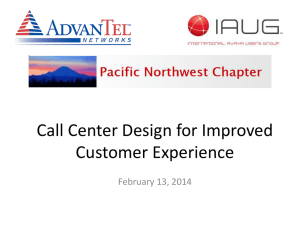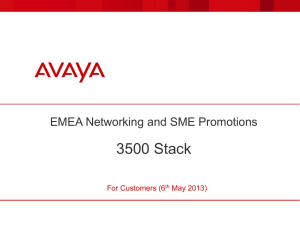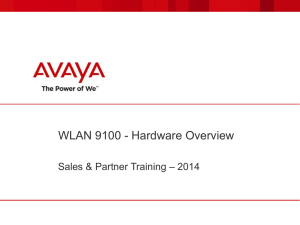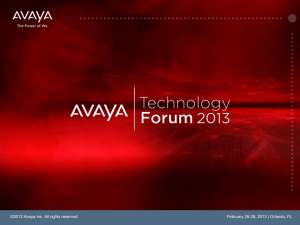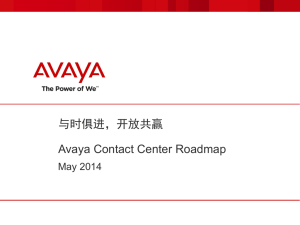ATF_2014_Private Networks for the Control of Critical Data
advertisement
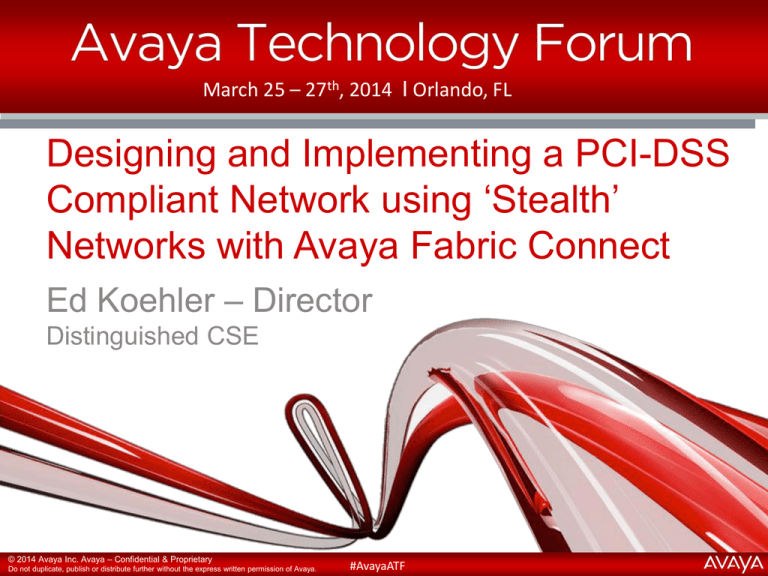
March 25 – 27th, 2014 І Orlando, FL Designing and Implementing a PCI-DSS Compliant Network using ‘Stealth’ Networks with Avaya Fabric Connect Ed Koehler – Director Distinguished CSE ©©2014 2014Avaya AvayaInc. Inc.Avaya Avaya– –Confidential Confidential& &Proprietary Proprietary DoDo not not duplicate, duplicate, publish publish oror distribute distribute further further without without the the express express written written permission permission of of Avaya. Avaya. #AvayaATF #AvayaATF Privacy in a Virtualized World Network and Service Virtualization have transformed the IT industry Cloud Services Software Defined Networking Security and privacy concerns are being expressed by many risk and security analysts Regulatory compliance in a virtualized environment can be a difficult bar to reach Examples are, PCI Compliance, HIPAA, Process flow and control (SCADA) environments, Video Surveillance © 2014 Avaya Inc. Avaya – Confidential & Proprietary Do not duplicate, publish or distribute further without the express written permission of Avaya. #AvayaATF 2 The Definition of a “Stealth” Network Any network that is enclosed and self contained with no reachability into and/or out of it. It also must be mutable in both services and coverage characteristics The common comparible terms used are MPLS IP-VPN, Routed Black Hole Network, IP VPN Lite Avaya’s Fabric Connect based on IEEE 802.1aq provides for fast and nimble private networking circuit based capabilities that are unparalleled in the industry “Stealth” Networks are private ‘dark’ networks that are provided as services within the Fabric Connect cloud L2 Stealth A non-IP addressed L2 VSN environment L3 Stealth A L3 VSN IP VPN environment © 2014 Avaya Inc. Avaya – Confidential & Proprietary Do not duplicate, publish or distribute further without the express written permission of Avaya. #AvayaATF 3 Use Case Requirements for “Stealth” Networks Networks that require isolation and security PCI compliance HIPAA compliance Financial Exchanges Video Surveillance (Unicast or Multicast) SCADA control networks Networks that require Services Separation Multicast - particularly video surveillance Bonjour SCADA © 2014 Avaya Inc. Avaya – Confidential & Proprietary Do not duplicate, publish or distribute further without the express written permission of Avaya. #AvayaATF 4 PCI DSS Compliance Requirements See https://www.pcisecuritystandards.org/documents/pci_dss_v2.pdf 1. Install and maintain a firewall configuration to protect cardholder data 2. Do not use vendor- supplied defaults for system passwords and other security parameters 3. Protect stored cardholder data 4. Encrypt transmission of cardholder data across open, public networks 5. Use and regularly update anti-virus software or programs 6. Develop and maintain secure systems and applications 7. Restrict access to cardholder data by business need-to-know 8. Assign a unique ID to each person with computer access 9. Restrict physical access to cardholder data 10. Track and monitor all access to network resources and cardholder data 11. Regularly test security systems and processes 12. Maintain a policy that addresses information security for employees and contractors © 2014 Avaya Inc. Avaya – Confidential & Proprietary Do not duplicate, publish or distribute further without the express written permission of Avaya. #AvayaATF 5 A Few Words on PCI DSS v 3.0… Over 100 new controls defined!!! Many are further clarifications on v 2.0 Main impacting changes Inventory of all systems within Card Holder Data Environment (CDE) Documented Card Holder data flows within CDE Detailed penetration testing requirements Concerns over ‘weak’ segmentation Further detail on the role & obligations of third parties and service providers Full network and data flow diagrams Penetration testing that ‘matches’ CDE as is deployed Incorporation of ‘business as usual’ PCI compliant processes and policies Change management and audit – both technical and organizational https://www.pcisecuritystandards.org/documents/PCI_DSS_v3.pdf © 2014 Avaya Inc. Avaya – Confidential & Proprietary Do not duplicate, publish or distribute further without the express written permission of Avaya. #AvayaATF 6 PCI-DSS & PA-DSS PCI-DSS deals with the whole end to end system implementation as it is deployed. PA-DSS (Payment Application Security Standard) defines what a compliant application must support as it is designed. PA-DSS is derived from PCI-DSS, defines handling of: Magnetic Stripe data Card Verification Codes & Values CAV2,CID,CVC2,CVV2 PIN’s & PIN Blocks PA-DSS compliance applies to ‘off the shelf’ payment applications Merchant or SP’s MUST certify ‘in-house’ applications! © 2014 Avaya Inc. Avaya – Confidential & Proprietary Do not duplicate, publish or distribute further without the express written permission of Avaya. #AvayaATF 7 About Network Segmentation… While not strictly required for compliance, it is strongly recommended! Network Segmentation can reduce: The scope of the PCI-DSS assessment The cost of the PCI-DSS assessment The cost and difficulty in maintaining systems compliance Major benefits of overall risk reduction in the systems model All of this can be realized IF the network segmentation is secure and properly designed! Proper design leads to consistency and modularity Allows for the streamlining of compliance by the use of sampling © 2014 Avaya Inc. Avaya – Confidential & Proprietary Do not duplicate, publish or distribute further without the express written permission of Avaya. #AvayaATF 8 What version 3.0 has to say about segmentation and CDE (Card Holder Data Environments) CDE includes all people, processes and technology Validation on ‘where’ Card Holder Data exists Trace processes and systems Develop flow diagrams of interacting systems & CHD Develop documented penetration testing specific to the CDE ‘Hack Attack’ methodologies Ongoing evaluation of threats/vulnerabilities/risk The more technologies involved in CDE the more penetration testing required! Fabric Connect used end to end eliminates most if not all other network technologies Fabric Connect (IEEE 802.1aq) Can significantly reduce ACL requirements and enhance data flow validation! Firewalls/IDS Servers/Storage and POS Authentication -> Identity Engines! Management applications!* * Important consideration to ‘lock down’ the mgmnt. environment. If it manages a system in the CDE. It is part of the CDE! © 2014 Avaya Inc. Avaya – Confidential & Proprietary Do not duplicate, publish or distribute further without the express written permission of Avaya. #AvayaATF 9 Identity Engines & Fabric Connect Support for PCI Compliance – includes v 3.0 requirments! There is no PCI ‘product’. Reports must be submitted to prove compliance. Identity aware networking systems can play a key role as one of the PCI Enforcement Tools to ensure that the PCI audits will prove successful. Payment Card data should be segmented and access control should be used to ensure only authorized resources have access to the Payment Card Data Network. PCI Standards PCI Enforcement Tools Control Objectives Build and Maintain a Secure Network Protect Cardholder Data Maintain a Vulnerability Management Program Implement Strong Access Control Measures Regularly Monitor and Test Networks Maintain an Information Security Policy PCI Validation Audit PCI Audit Report PCI DSS Requirements 1. Install and maintain a firewall configuration to protect cardholder data 2. Do not use vendor-supplied defaults for system passwords and other security parameters 3. Protect stored cardholder data 4. Encrypt transmission of cardholder data across open, public networks 5. Use and regularly update anti-virus software on all systems commonly affected by malware 6. Develop and maintain secure systems and applications 7. Restrict access to cardholder data by business need-to-know 8. Assign a unique ID to each person with computer access 9. Restrict physical access to cardholder data 10. Track and monitor all access to network resources and cardholder data 11. Regularly test security systems and processes 12. Maintain a policy that addresses information security (*) Supported by Identity Engines © 2014 Avaya Inc. Avaya – Confidential & Proprietary Do not duplicate, publish or distribute further without the express written permission of Avaya. #AvayaATF 10 Identity Management and the ‘Series of Gates’ Security Concept End User Identity Broker (IDE) Fabric Connect Network Elements Secure PA-DSS Application General Access challenge General Access PCI-DSS challenge L3 VSN Secure Access Authentication Access ONLY! © 2014 Avaya Inc. Avaya – Confidential & Proprietary Do not duplicate, publish or distribute further without the express written permission of Avaya. #AvayaATF 11 Anatomy of a Layer 3 Stealth Network (IP VPN) A SPB I-SID that is associated with End VRF’s Multiple IP subnets – completely separate & private environment Provides for a closed IP internet environment IP forwarding Fabric Connect Cloud VRF I-SID VLAN Subnet A VRF Secure L3 “Stealth” Network (IP VPN) VLAN Subnet B http://www.youtube.com/watch?v=umR6u5VVdGU © 2014 Avaya Inc. Avaya – Confidential & Proprietary Do not duplicate, publish or distribute further without the express written permission of Avaya. #AvayaATF 12 Anatomy of a Layer 2 Stealth Network A SPB I-SID that is associated with End VLAN’s No IP addresses assigned* Provides for a closed non-IP or single subnet IP based network Typically when used within the Data Center for PCI-DSS systems (IP addresses can be used behind security perimeter*) No IP No IP Fabric Connect Cloud I-SID VLAN VLAN Secure L2 “Stealth” Network http://www.youtube.com/watch?v=pGSYmqAbjBU © 2014 Avaya Inc. Avaya – Confidential & Proprietary Do not duplicate, publish or distribute further without the express written permission of Avaya. #AvayaATF 13 End-to-End Usage of Stealth networks for PCI-DSS Compliance – Example Topology L3 VSN’s are used and terminated at the field service edge – Alternately ‘Stealth’ L2 VSN’s can also be used ‘Stealth’ L2 VSN’s are used within the Secure Data Center Identity Engines provides for access control and protection of the PCI-DSS environment Secure Single Port PCA-DSS Application Data Center (Server) Fabric Connect Cloud VRF VLAN FW/IDS Subnet A Secure L2 “Stealth” Networks © 2014 Avaya Inc. Avaya – Confidential & Proprietary Do not duplicate, publish or distribute further without the express written permission of Avaya. IDE #AvayaATF I-SID Core Distribution PCA-DSS Application (Client) VRF Secure L3 “Stealth” Network (IP VPN) VLAN Subnet B 14 Fully Virtualized Security Perimeter Data Center Top of Rack VLANs Secure L2 VSNs VLANs Data Center 1 Secure Data Center VLAN IDE Core Network Data Center VRFs* *optional Firewalls VLAN IDS/IPS VLAN Other user VLANs Secure L3 VSN Secure End User VLAN © 2014 Avaya Inc. Avaya – Confidential & Proprietary Do not duplicate, publish or distribute further without the express written permission of Avaya. VLANs Virtualized Security Perimiter Data Center 2 Fabric Connect Other user VLANs Secure End User VLAN #AvayaATF 15 Fully Virtualized Security Perimeter Data Center Top of Rack Secure L2 VSNs VLANs VLANs Fabric Connect Data Center 1 Secure Data Center Core Network VLAN VLAN VLAN Other user VLANs Data Center VRFs* *optional VLAN Virtualized Security Perimiter IDE IDE Secure L3 VSN © 2014 Avaya Inc. Avaya – Confidential & Proprietary Do not duplicate, publish or distribute further without the express written permission of Avaya. Firewalls VLAN IDS/IPS Card Holder Data Environment Secure End User VLAN Data Center 2 VLAN Other user VLANs Secure End User VLAN #AvayaATF 16 The scoop on Sampling… Sampling allows for the ability to drastically reduce the overall complexity (and cost) of compliance Requires consistency and modularity in order to provide for maximum return Modules of the overall solution can be built and templated. Faithful reproduction is strictly required! Can drastically reduce compliance costs and ongoing maintenance BEWARE! Small divergence in details CAN cause NONCOMPLIANCE i.e. PA-DSS app. “A” on OS “1” is different from PA-DSS app. “A” on OS “2” Or storage on FC is different from iSCSI or NAS V 3.0 increases focus on end to end validation of CDE. Templates and consistency are more important than ever! Penetration testing methods should be developed and documented © 2014 Avaya Inc. Avaya – Confidential & Proprietary Do not duplicate, publish or distribute further without the express written permission of Avaya. #AvayaATF 17 As per ‘Appendix D’… does not change in v3.0 Fabric Connect addresses all segmentation requirements! © 2014 Avaya Inc. Avaya – Confidential & Proprietary Do not duplicate, publish or distribute further without the express written permission of Avaya. #AvayaATF 18 Modularity and Sampling Concept Data Center Systems Storage Systems Compute Systems Firewall/IDS Security Demarcation Remote site systems App/OS Switch/Network Secure Single Port PCA-DSS Application Data Center (Server) Fabric Connect Cloud VRF VLAN Network Distribution Systems FW/IDS Subnet A Secure L2 “Stealth” Networks Do not duplicate, publish or distribute further without the express written permission of Avaya. VRF VLAN Subnet B IDE © 2014 Avaya Inc. Avaya – Confidential & Proprietary I-SID Core Distribution PCA-DSS Application (Client) Secure L3 “Stealth” Network (IP VPN) #AvayaATF 19 PCI-DSS Compliance Design Checklist Terminate L3 VSN’s as close to the edge as possible When it is not possible. Extend to edge with Secure “Stealth” L2 VSN’s off of the VRF* Limit port membership into Security Demarcation points. Single port ideally Limit port memberships to ONLY PA-DSS endpoints IDE can provide for complete assurance of proper network placement and ID Management of PA-DSS systems. Be sure to limit ONLY PA-DSS applications to the Dark Horse environment Validate Firewall Security Policy Databases (TEST!) Any public Internet or Wireless usage will require encryption MACsec can be used for Ethernet Trunk protection where required IPSec and SSL VPN can be used for secure remote VPN Develop a detailed network diagram of how the CDE relates to the whole network topology with a focus on isolation methods Highlight Card Holder Data flow * Multicast is NOT supported in this configuration © 2014 Avaya Inc. Avaya – Confidential & Proprietary Do not duplicate, publish or distribute further without the express written permission of Avaya. #AvayaATF 20 In Conclusion… While IP Virtual Private Networks are nothing new, Avaya takes the concept to a new level with Fabric Connect Flexible and nimble service extensions and nodal mutability lend itself to an incredibly mobile secure networking paradigm “Stealth” Networking – Fast, nimble and invisible “Stealth” Networks can be used to facilitate traditional privacy concerns such a PCI and HIPAA compliance Next generation private network requirements such as mobility for emergency response, military and/or field based operations Avaya’s Fabric Connect can deliver all modes of secure private connectivity Layer 2 requirements Layer 3 requirements Mobile requirements © 2014 Avaya Inc. Avaya – Confidential & Proprietary Do not duplicate, publish or distribute further without the express written permission of Avaya. #AvayaATF 21 Ed Koehler You Tube Channel https://www.youtube.com/channel/UC n8AhOZU3ZFQI-YWwUUWSJQ Blog – http://edkoehler.wordpress.com/ © 2014 Avaya Inc. Avaya – Confidential & Proprietary Do not duplicate, publish or distribute further without the express written permission of Avaya. #AvayaATF #AvayaATF BEST OF ATF SPEAKER AND TEAM AWARD BE SURE TO TWEET YOUR FEEDBACK ON THIS PRESENTATION #AvayaATF Winners will be announced at closing of event © 2014 Avaya Inc. Avaya – Confidential & Proprietary Do not duplicate, publish or distribute further without the express written permission of Avaya. #AvayaATF 23 #AvayaATF

